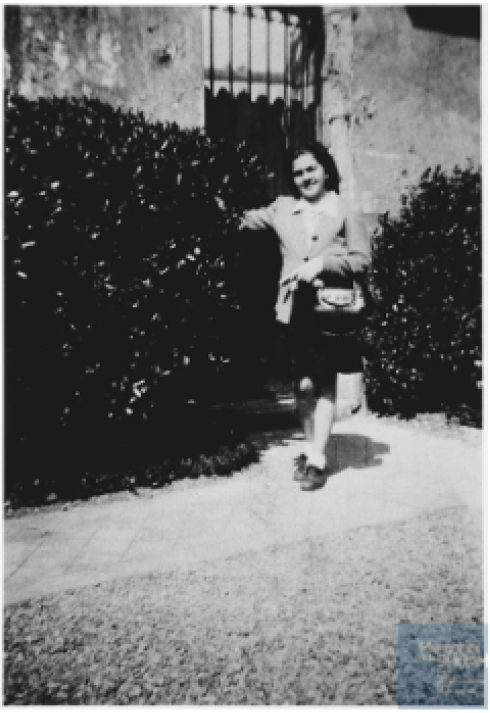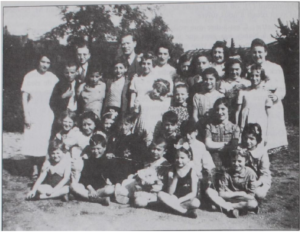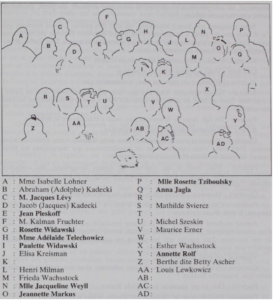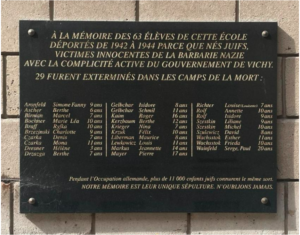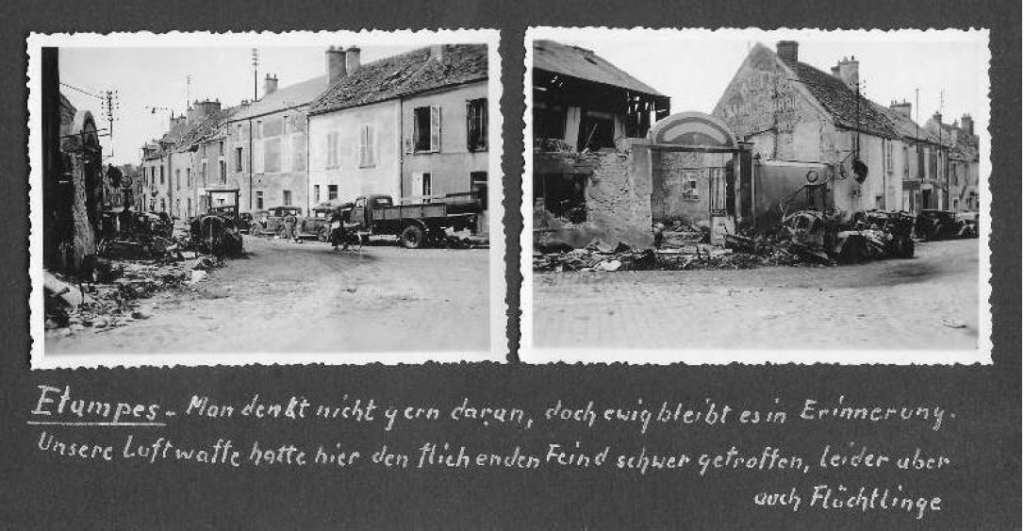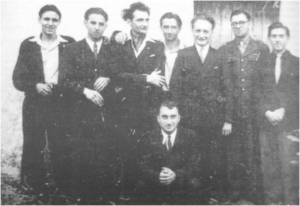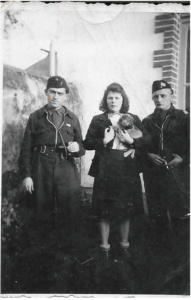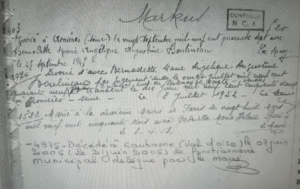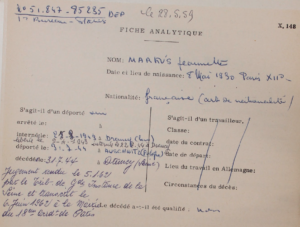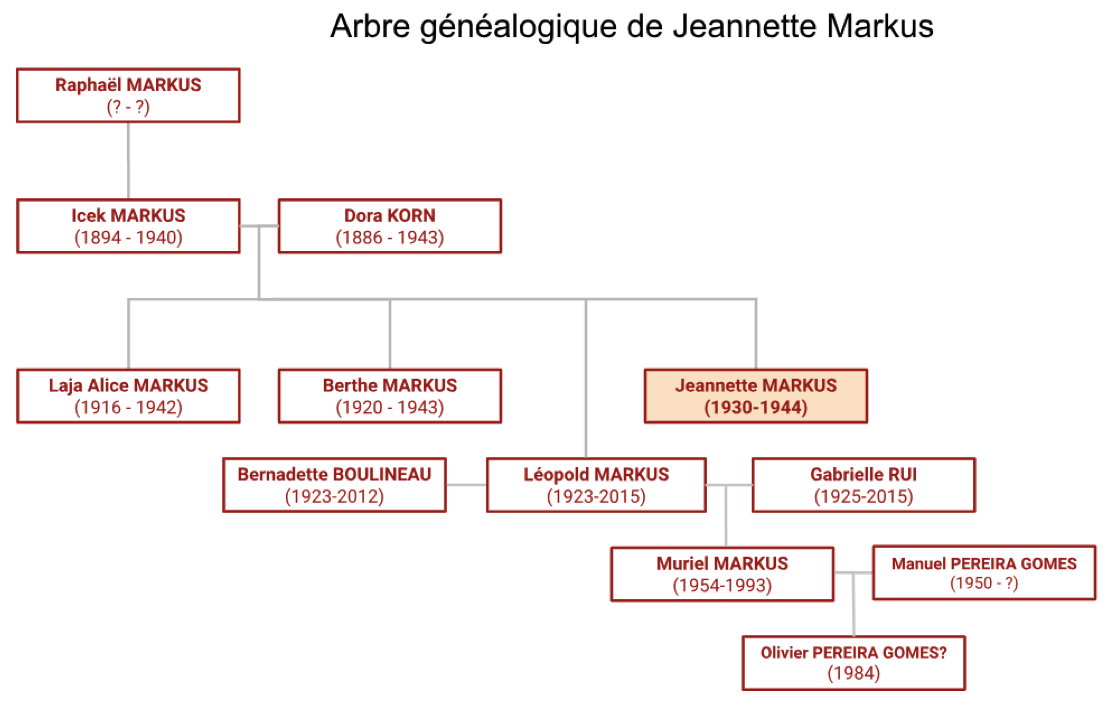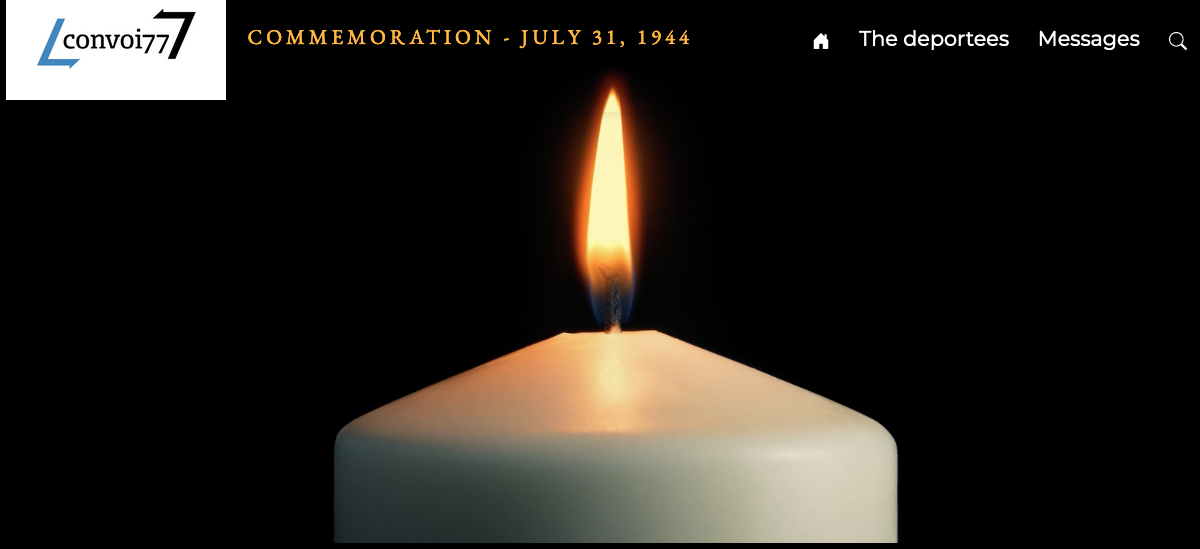Jeannette MARKUS
Photo : Jeannette devant le portail de l’UGIF, publié par Serge Klarsfeld dans le Mémorial des enfants juifs déportés de France.
Introduction
During the Second World War, the Jews were victims of genocide perpetrated by Hitler and the Nazis. France was invaded by the Nazis in 1940. The Vichy regime participated in this genocide. Tens of thousands of French Jews were exterminated in the killing centers, as was the case with Jeannette Markus and her family. This is her story.
1 – Jeannette
Jeannette Markus was born on May 8, 1930 in the 12th arrondissement of Paris. On her birth certificate, her parents are listed as living at 18 rue de Belleville in 1930.
She is the daughter of Icek and Dora Markus and sister of Alice, Berthe and Léopold. She is of Polish origin, but appears as French in all documents consulted, as in the Constantin Pecqueur school register.
From February 2, 1937, she attends the Constantin Pecqueur school in the 18th arrondissement of Paris. In the school records, Jeannette is described as “a nice child” with an “average” academic level. When she enrols at the school on February 2, 1937, her address is 22 rue Francoeur, in the 18th arrondissement. The register shows that Jeannette had previously attended a school in Jouy-le-Moutier (95), then in Pontoise (95). The last known address of the Markus family, as mentioned on the Drancy internment form, is the 22 rue Francoeur, in Paris’s 18th arrondissement. She was rounded up a first time on March 25th, 1943, at the age of 14 along with her sister Berthe. They are then interned in Drancy.
Registre d’école consulté en salle de lecture aux Archives de Paris, Paris XIX
On April 9, 1943, Jeannette is freed, probably because she is French and she is a minor. Berthe, on the other hand, is deported to Auschwitz. Jeannette spends a year in a home for young Jewish children, with no one to look after her (see below the biographies of the other members of the family). The home was located at 21 rue François-Debergue in Montreuil, and was run by the UGIF (Union Générale des Israélites de France). The testimonies of two young girls, Rosette and Paulette, born Widawski, who lived in the home with Jeannette before being deported themselves, give us some insight into her character: “In Montreuil, I remember Jeannette Markus […] Jeannette Markus was the leader of a team that included Anna Jagla, and Anna Jagla had become her idol. When I arrived, I created another group where there was Rosette, where there were… all the others, you understand?” ”
Montreuil-sous-Bois, juin 1943
Enfants et moniteurs du centre n° 52 de l’U.G.I.F.
Collection Henri Tziboulsky. Mémoires juives. Patrimoine photographique.
During this period, she attended the Marcelin-Berthelot school in Montreuil. Today, there’s a plaque commemorating all the Jewish children who were deported. Jeannette’s name appears on it.
She is rounded up a second time on July 22, 1944, along with 14 other young children and 3 instructresses. All children and caregivers from UGIF homes in Paris and the suburbs are then interned at Drancy, on the orders of SS officer Alois Brunner. 243 children living in UGIF homes were interned at Drancy.
From Laloum’s Les Juifs dans la banlieue parisienne, we understand that Jeannette had ties with the Bernholc family. Madeleine, who wrote this letter to Laloum in 1991, was the daughter (aged nine at the time) of Jeannette’s correspondents when she lived in Montreuil. Jeannette seems to have chosen the name Jeanine, at least with the Bernholc family. Here’s an extract from the book about Jeannette:
“The one who is called ‘their daughter’ is Madeleine, the Bernholc couple’s daughter. What she relates takes place at the Liberation (when they went to Montreuil). When I arrived home,” recalls their daughter, ”I asked about Jeanine. Dad and I went to Montreuil in the hope of bringing her home. When we arrived, no one was there. The neighbors told us the Germans had taken them all away. One day, a man brought us a letter, apologizing for the delay in getting here. He was a railway worker, and had found this envelope on the tracks. Inside were photos of his family and a little farewell note, written in pencil: ‘I hope this letter reaches you, where I’m going there’s no coming back’”.
Jeannette was deported to Auschwitz on July 31, 1944, on convoy 77, where she was killed on August 5, 1944. It is assumed that she survived the train journey and was murdered on arrival in a gas chamber.
On March 26, 2006, a memorial plaque was installed in the Constantin Pecqueur elementary school (Paris XVIII arrondissement) attended by Jeannette, along with several other names of Jewish children deported and exterminated during the Holocaust.
Plaque commémorative de l’école Marcelin-Berthelot, à Montreuil
2 – Jeannette’s father: Icek MARKUS
Icek was born in Wieluna, Poland, on January 13, 1894. Icek probably met his wife Dora around Wieluna, who was also born there in 1886. We assume that they immigrated to France between 1916 and 1920, as Laja-Alice, their first daughter, was born in Poland, while Berthe, their second daughter, was born in France in 1920.
In France, Icek changed his first names several times to fit in: he can be found as Isaac or Isidore. These name changes were common to many Eastern European immigrants who settled in France from the 1920s onwards. Icek was a dishwasher, then a baker.
During the outbreak of war, we assume he lived with his family at 22 rue Francoeur (Paris XVIII arrondissement). On June 16, 1940, Icek died in a bombing raid in Étampes, provoked by Germany, as he was probably fleeing the German invasion. It is known that Icek was accompanied by his wife, and that they lost touch during the Exodus. According to an information sheet available from the Étampes municipal archives, he was hospitalized at the Hôtel-Dieu d’Étampes, where he breathed his last despite the care he received. We assume that Jeannette was also on the exodus, as she was still young.
Album photo des bombardements à Etampes, photos prises à Etampes par un soldat allemand de passage en juin 1940, mis en ligne par le Corpus Etampois.4
3 – Jeannette’s MOTHER, Dora MARKUS (maiden name KORN)
Dora Korn (often written as Corn) was born in 1886, in Wieluna, in Poland. Dora Korn was married to Icek Markus. Dora and Icek had four children, Alice, Berthe, Léopold and Jeannette. Dora was a housewife.
On February 11, 1943 Dora is interned in Drancy Camp. She is deported on March 23, 1943 in the convoy 52 to the extermination center of Sobibor.
She dies on March 28, 1943, very certainly in a gas chamber, when the convoy arrived.
4 – Jeannette’s oldest sister : Laja Alice MARKUS
Laja Alice Markus was born on Sept’ember 26, 1916, in Wieluna, in Poland. She was an artistic secretary in 1943. According to Guylène Trajan, a descendant of a friend of Leopold Markus, she used to work in a Paris cinema when war broke out. According to an extract of the 1931 census, Alice was a “dactylo”.
She is the first of the Markus family to be deported. She was interned in Drancy (date unknown) then was deported to Auschwitz-Birkenau on September 30, 1942, in the convoy 39.
She dies on October 5, 1942, in Auschwitz.
5 – Jeannette’s second sister : Berthe MARKUS
Berthe Markus was born on November 1st, 1920, in the 12th arrondissement of Paris. When she was born, the family lived at 5 bis rue de la Présentation, in the 10th arrondissement. She was an accountant in 1943. She is interned in Drancy on March 25, 1943. She was deported to Auswchitz on June 23, 1943 in the convoy 55. She dies on June 28, 1934 in Auschwitz.
Jeannette was arrested at the same moment than Berthe but was released from Drancy on April 9, 1943. It was the last time they saw each other.
6 – Le grand frère de Jeannette, Léopold Markus
Photo du groupe de résistants dirigé par Léopold, mis en ligne par le site Vendée Résistance et dans un article intitulé “Mervent : la Résistance honorée” du Ouest France du 19 août 2001
Léopold was born on February 7, 1923 in the 12th arrondissement of Paris. He is the third child of the Markus family, after Alice and Berthe. He is Jeannette’s older brother. When Léopold was born, the Markus family lived at 53 boulevard de Belleville, in the 20th arrondissement of Paris.
De gauche à droite : Léopold, Colette et Robert
Durant la Seconde Guerre mondiale, Léopold est résistant. Depuis Paris, il est envoyé en Vendée. Il sert au sein du groupe des Forces Françaises Intérieures (FFI) “Guy Môquet”, situé en Vendée, dans la forêt de Mervent. Ce groupe est dirigé par Léopold et Robert Brunet. Des documents des FFI datés de 1944 nous indiquent qu’il était surnommé “Loulou”, et qu’il était considéré comme “le tueur de la Résistance”, après avoir exécuté un milicien. “Le 8 mai 1944, une première équipe mobile est formée sous le commandement du lieutenant Léopold Marcus (ou Markus) dit Leroy, vingt et un ans, passé dans la mémoire populaire sous le nom de Loulou. Le groupe est appelé “Guy Môquet”, en souvenir du jeune homme fusillé avec les vingt-sept otages de Châteaubriant le 22 octobre 1941. Quant à Léopold Markus, on sait qu’il était d’origine juive polonaise et qu’il avait de fortes raisons d’entrer en lutte armée contre les nazis et leurs collaborateurs français.”[4] Plusieurs actes de résistances sont recensés, comme des sabotages de ligne téléphonique de chemin de fer. Nous savons également que lors d’un acte de sabotage à la Roche-sur-Yon, Loulou, pour échapper à des miliciens, se réfugie à l’hôtel du Croissant, place circulaire à la Roche-sur-Yon. Il arrive à s’échapper par les toits, avec l’aide de la fille du patron de l’hôtel. Ensuite, “le vendredi 21 juillet, Loulou et un camarade reçoivent l’ordre (ou l’autorisation) de s’attaquer à un gros gibier. Ils ont observé que le secrétaire départemental de la Milice, Alain de Gouyon, rentrait chaque soir à son domicile de Saint-André-d’Ornay vers 18h (20h à l’heure officielle allemande) ; infirme, il se déplaçait en voiturette. Cible facile, mais de première importance et dont l’atteinte ne manquerait pas d’impressionner. Mais elle pouvait aussi être lourde de conséquences pour le tireur, et pour la population, en ce mois de juillet où la percée d’Avranches n’avait pas encore ouvert la route de Paris et de l’Allemagne aux armées alliées et découragé les derniers vichystes de sévir. Les deux FTP à bicyclette suivent la voiturette. Loulou abat le milicien d’un coup de revolver dans la nuque.”[5] Après cette exécution, Léopold Markus trouve refuge chez Églantine Daviet, une commerçante à la Chaize-le-Vicomte. Le lieutenant Léopold Markus fait acquitter Mme Daviet le 24 janvier 1945 alors qu’elle est accusée à la chambre civique d’avoir “trafiqué avec les Allemands”. Léopold témoigne : “Lors de l’attaque du maquis de Château-Fromage, je me suis réfugié avec mes camarades chez Madame Daviet ; elle nous a toujours bien reçu. Le soir du meurtre du chef milicien de Gouyon, elle nous a également hébergés et cachés”.[6] Léopold opère aussi dans le maquis de la forêt de Mervent (Vendée). Il récupère des armes, incendie un convoi allemand à Breuil Barret et exécute des miliciens. Après la guerre, il garde des contacts amicaux avec la famille Trajan, dont certains membres étaient dans la Résistance à ses côtés. Guylène Trajan dont le père était camarade de Léopold nous dit : “[…] ma famille avait de l’amitié pour Léopold dont on a surtout retenu en Vendée qu’il était le tueur de miliciens. Bien que FTP, je ne pense pas qu’il était communiste, mais il avait la rage, c’est vrai. Il voulait en découdre, ce qui semble bien humain avec ce qu’il a vécu. […]”.
Selon les notes inscrites par l’officier de l’état civil dans la marge de l’acte de naissance de Léopold, il se marie une première fois le 24 septembre 1947 avec Bernadette Marie Angélique Augustine Boulineau (née le 3 février 1923 à Mouilleron-le-Captif et décédée en 2012 à La Roche-sur-Yon) à Asnières, le 20 Septembre 1947. Ils divorcent le 20 juillet 1949 au Tribunal de Fontenay-le-Comte.
Marge de l’acte de naissance de Léopold Markus, consulté aux Archives de Paris, Paris XIX
During World War Two, Léopold was a member of the Resistance. After Paris, he was sent to the Vendée. He was a very important member of group called “Guy Môquet” in the Forces Françaises Intérieurese (FFI) located in the Vendée, in the Mervent forest. This group was led by Léopold and Robert Brunet. Documents from the FFI in 1944 tell us that he was named “Loulou” and considered as “the killer of the Resistance” after he killed a militiaman.
“On May 8, 1944, a first mobile team was formed under the command of Lieutenant Léopold Marcus (or Markus), known as Leroy, twenty-one years old and known in popular memory as Loulou. The group was named “Guy Môquet”, in memory of the young man shot along with the twenty-seven Châteaubriant hostages on October 22, 1941. As for Léopold Markus, we know he was of Polish Jewish origin and had strong reasons for joining the armed struggle against the Nazis and their French collaborators.”
Several acts of resistance are recorded, including sabotage of telephone and railroad lines. We also know that during an act of sabotage in La Roche-sur-Yon, Loulou took refuge from militiamen at the Hôtel du Croissant in the circular square. He managed to escape through the roofs, with the help of the hotel owner’s daughter. Then, “on Friday July 21, Loulou and a comrade were ordered (or authorized) to attack a very important target. They had observed that Alain de Gouyon, the departmental secretary of the Militia, returned to his home in Saint-André-d’Ornay every evening at around 6pm (8pm in official German time). An easy target, but one of prime importance, and one that would not fail to impress. But it could also have had serious consequences for the shooter, and for the population, in this month of July when the Avranches breakthrough had not yet opened the road to Paris and Germany for the Allied armies, and discouraged the last Vichyists from cracking down. The two FTPs on bicycles follow the cart. Loulou shoots the militiaman in the back of the head with a revolver.” After the execution, Léopold Markus found refuge with Églantine Daviet, a shopkeeper in La Chaize-le-Vicomte. Lieutenant Léopold Markus had Mme Daviet acquitted on January 24, 1945, when she was accused in the civic chamber of having “dealt with the Germans”. Léopold testifies: “During the attack on the Château-Fromage maquis, I took refuge with my comrades at Madame Daviet’s; she always made us feel welcome. On the evening of the murder of the Gouyon militia leader, she also gave us shelter and concealed us. Léopold was also active in the maquis in the Mervent forest (Vendée).
He collected weapons, set fire to a German convoy at Breuil Barret and executed militiamen. After the war, he kept in friendly contact with the Trajan family, some of whose members had served with him in the Resistance. Guylène Trajan, whose father was one of Léopold’s comrades, tells us: “[…] my family had a friendship with Léopold, who is best remembered in the Vendée for killing militiamen. Although he was an FTP, I don’t think he was a Communist, but he had rage, it’s true. He wanted to fight, which seems quite human given what he went through. […]”.
According to the notes in the margin of Léopold’s birth certificate, he was married for the first time on September 24, 1947 with Bernadette Marie Angélique Augustine Boulineau (born February 3, 1923 in Mouilleron-le-Captif, died 2012 in La Roche-sur-Yon) in Asnières, on September 20, 1947.
Léopold got married a second time on March 28, 1953, with Gabrielle, Marie, Hélène Rui (born in Caen on April 10, 1925 and passed away on February 13, 2015 in Montigny-lès-Cormeilles).
They had a daughter named Muriel Jeaninne Markus, born in the 10th arrondissement of Paris, on November 13, 1954. Muriel is therefore Jeanette’s niece. The family lived in the 10th arrondissement of Paris when Muriel was born, at 186 rue du Faubourg Saint-Denis. Léopold was a radio technician and Gabrielle did not work.
Muriel Markus married Manuel Pereira Gomes on January 29, 1977. She was a secretary and Manuel was a trained operator. Muriel passed away on September 2, 1994.
We have every reason to believe that Manuel is still alive and lives in Beauchamp. We have tried to reach him but never heard back.
Muriel and Manuel had a son, Olivier Pereira Markus. Again, we tried to reach him but he has not yet answered our call.
Leopold passed away on July 7, 2005 in Eaubonne.
Fiche analytique extrait du dossier de démarches administratives entamé par Léopold Markus
MARKUS Family chronology
- Birth of Dora in 1886, in Wielun, Poland.
- Birth of Icek in 1893, in Wielun, Poland.
- Birth of Laja Alice in 1916, in Wielun, Poland.
- Arrival of the Markus family in France after 1916.
- Birth of Berthe in 1920. Family domiciled at 5 bis rue de la Présentation, Paris 11.
- Birth of Léopold in 1923. Family domiciled at 53 boulevard de Belleville, Paris 20.
- Birth of Jeannette in 1930. Address unknown at that time.
- Jeannette attends the Place Constantin Pecqueur school (18th arrondissement) from January 1937.
- Exodus of the Markus family (Icek and Dora sur) in June 1940. Icek dies.
- The family returns to Paris, in the 18th arrondissement, 22 rue Francoeur.
- Laja Alice is deported in September 42.
- Dora interned in February 43 and deported on March 23, 43.
- Berthe and Jeannette were interned on March 25, 43, two days after Dora’s deportation.
- Jeannette was released on April 9, 43, and placed under UGIF control in the Montreuil hostel.
- Berthe was deported on June 23, 43.
- Jeannette attends the Marcelin Berthelot school.
- Jeannette is rounded up and interned at Drancy on July 22, 43.
- Jeannette is deported on July 31, 44.
- Léopold executes Alain de Gouyon, a militiaman, on July 21, 44.
- Léopold marries Bernadette Boulineau on September 20 47.
- Léopold and Bernadette divorce in 1949.
- Léopold marries Gabrielle RUI in 1953.
- Birth of Muriel Markus in 1954 in Paris X, daughter of Léopold and Gabrielle.
- Léopold begins proceedings for Jeannette in 1959.
- Muriel marries Manuel Pereira Gomes on January 29, 1977.
- Birth of Olivier, Léopold’s grandson, in 1984.
- Muriel dies in 1993, in Pontoise.
- Léopold died in 2005, in Eaubonne.
- Gabrielle died in 2015.


 Français
Français Polski
Polski